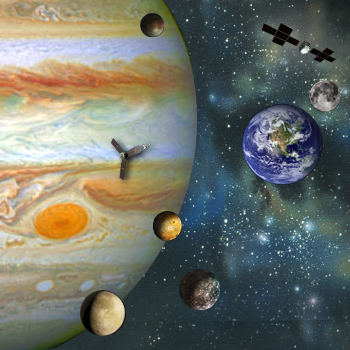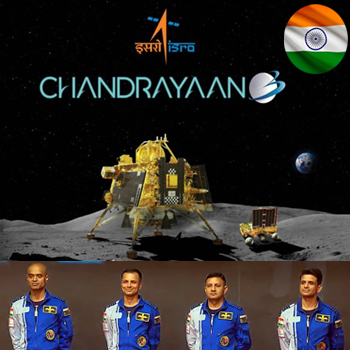JUICE to Perform First-Ever Flyby of Earth-Moon on Path to Jupiter 2031
|
MONDAY☆ Aug 19 — International Space Station, ~415-km LEO: Expedition 71 seven members transferring cargo from newly arrived Progress 89P, which brings craft currently docked to ISS to 6 total along with Soyuz MS-25, Crew-8 Dragon, Starliner CST-100, Cygnus 21, Progress 88; NASA to determine by end of August if two Boeing Starliner Astronauts Williams and Wilmore will stay aboard ISS until 2025 (8-month mission) for return flight aboard SpaceX Dragon. ☆ Aug 19 — Tiangong Space Station, ~390-km LEO: Shenzhou 18 three-member crew work with science experiments, perform cardiovascular and respiratory tests, train using remote-control systems for rendezvous & docking operations, create short video to honor summer Olympics. ☆ Aug 19-20 — JUICE, Jupiter Trajectory: ESA Jupiter Icy Moons Explorer (JUICE) expected to perform first-ever flyby of Earth-Moon system this month, arriving at Jupiter in 2031. ☾ Aug 19 — Moon: Full Sturgeon / Super, Blue Moon, 08:27. ☆ Aug 19 — Apollo Asteroid 2024 JV33: Near-Earth Flyby (0.030 AU) Ongoing… ☆ NET Jul — ISRO, Launch LVM-3 (Launch Vehicle Mark-3) / Gaganyaan G2, Satish Dhawan Space Center, Sriharikota, India: India planning for 1st uncrewed flight of Gaganyaan on a short orbital test flight. o Jul 1 – Aug 30 — Academia Sinica Institute of Astronomy and Astrophysics, Taipei, Taiwan: 2024 Summer Student Program; students conduct original research under supervision of professional astronomers. |
 |
● = Terrestrial and… o = International terrestrial events
☾ = Moon activity ★ = Space and… ☆ = International space / astro events; in Hawaii Standard Time unless noted. Add 10 hours to obtain UT (‘Universal Time’). |
Weekly Planet Watch – Morning Planets: Mars (E), Jupiter (E); Evening Planet: Saturn (E).
India Celebrates Chandrayaan-2 and -3, Plans Lunar Sample Return 2028, Vyomanaut on the Moon 2040
The Chandrayaan robotic lunar missions led by ISRO will continue, according to Director S Somanath, until a Vyomanaut lands on the Moon. India is progressing on its Gaganyaan human spaceflight program and the Next Generation Launch Vehicle (NGLV or “Soorya”) to help complete the Indian Space Station by 2035 and send an Indian to the Moon by 2040. It also signed the Artemis Accords in 2023 for lunar exploration, which should open up other opportunities within the decade for further India Moon missions. This week, Chandrayaan-2 reaches 5 full years in lunar orbit on August 20 – it continues to provide surface mapping, optical and infrared imaging, radar measurement and other data from its 8 science instruments. On August 23, Chandrayaan-3 is celebrated for the first observation of India’s successful Moon landing, making India the fourth country to accomplish a touchdown on the Moon and first near the Moon South Pole. The private NewSpace enterprise sector in India is also booming, and the next robotic mission to the Moon surface from India, Chandrayaan-4, should see involvement from commercial space. The mission will attempt to return lunar samples to Earth from Statio Shiv Shakti, the same location where Chandrayaan-3 is located. Advanced Chandrayaan-4 technologies, such as rendezvous and docking capabilities, will aid the future Bharatiya Antariksha Station (first module launch 2028) and human Moon landings. (Pictured: Four current India vyomanauts; Image credits: ISRO) |
TUESDAY★ Aug 20 — Chandrayaan-2, Moon Orbit: India craft reaches 5th full year / enters 6th year in lunar 100-km polar orbit since reaching Moon in 2019. ★ Aug 20 — Voyager 2, Interstellar Space: NASA spacecraft reaches 47th full year / begins 48th year in space today, launched Aug 20, 1977, seventeen days before Voyager 1; expected to send data to Earth until ~2025 when power may run out. ★ Aug 20 — SpaceX, Launch Falcon 9 / Starlink Group 10-5, SLC-40, Cape Canaveral SFS FL: Falcon 9 to launch next batch of Starlink v2-mini satellites; 05:20 EDT. ● Aug 20 — LPI, USRA, NASA, Online / Houston TX: Lunar Surface Science Workshop 24: Science Drivers and Capabilities for Lunar Surface Habitat Research Facilities. ● Aug 20 — Federal Aviation Administration, Online: Meeting to obtain public input on SpaceX application to increase launch and landing cadence for Starship / Super Heavy at Starbase in Boca Chica, Texas; final of five meetings. ● Aug 20 — Maryland Space Business Roundtable (MSBR), Greenbelt MD: MSBR Luncheon; featuring a panel discussion on Space Emerging Technologies with A.C. Charania (NASA Chief Technologist) and Lisa Costa (former U. S. Space Force Chief Technology and Innovation Officer). o Aug 20-23 — University of Vienna, Institute for Astrophysics, Vienna, Austria: The BRITE Side of Stars. ☾ Aug 20 — Moon: 0.44° N of Saturn, 17:00; At perigee, (distance 360,174.69 km), 19:10. WEDNESDAY★ Aug 21 — SpaceX, Launch Falcon 9 / Starlink Group 9-5, SLC-4E, Vandenberg SFB CA: Falcon 9 to launch next batch of Starlink v2-mini satellites; 01:47 PDT. o Aug 21-22 – Space Industry Association of Australia, Canberra, Australia: Southern Space 2024. ☾ Aug 21 — Moon: 0.74° N of Neptune, 13:00. THURSDAY☆ Aug 22 — Apollo Asteroid 354182 (2002 DU3): Near-Earth Flyby (0.022 AU) |
FRIDAY
☾ Aug 23 — Chandrayaan-3, Shiv Shakti Point, Moon (69.373°S, 32.319°E): First annual observation of Vikram lander and Pragyan rover successfully landing on Moon in 2023, and India becoming 4th country to land on Moon, 1st near the Moon South Pole.
☆ Aug 23 — Amor Asteroid 2020 QW3: Near-Earth Flyby (0.071 AU)
SATURDAY
● Aug 24 — Ad Astra Kansas Foundation, Space Age Publishing Company, Hutchinson KS: Galaxy Forum Kansas 2024: Hutchinson; at Cosmosphere, free.
o Aug 24-31 — European Astrobiology Institute, University of Tartu, Stockholm University Astrobiology Centre, Tartu, Estonia: Workshop: Microsatellites and Their Use in Planetary and Astrobiology Research.
☆ Aug 24 — Aten Asteroid 2023 QR1: Near-Earth Flyby (0.059 AU)
SUNDAY
★ Aug 25 — Voyager 1, Interstellar Space: NASA spacecraft reaches 12th full year / begins 13th year in interstellar space, data indicates it became first human-made object to enter interstellar space Aug 25, 2012; launched Sep 5, 1977.
☾ Aug 25 — Moon: 4.3° NNW of Uranus, 13:00; with Uranus and Pleiades within circle of diameter 5.31°, 16:00; 0.24° NE of Pleiades, 18:00; at last quarter, 23:28.
☆ Aug 25 — Amor Asteroid 2024 PM3: Near-Earth Flyby (0.096 AU)

